
Application Notebook
However, as the saying goes, things are rarely as good or as bad as they seem.

Application Notebook
However, as the saying goes, things are rarely as good or as bad as they seem.
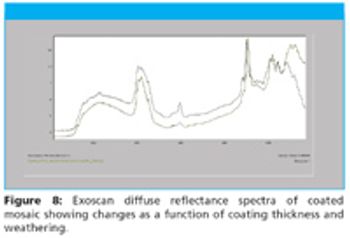
Application Notebook
As has been previously discussed (1), FTIR spectroscopy is emerging as a technique that can be effectively used for applications and/or in locations that heretofore would be considered too demanding. The development of portable FTIRs, and more recently handheld FTIRs, is significant because it enables this powerful analytical technique to solve problems for a whole range of new applications, both in the laboratory, and out of the laboratory.
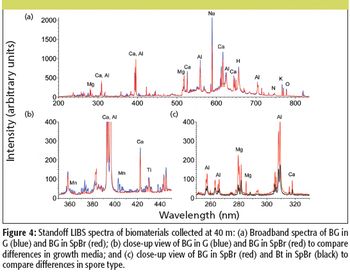
Application Notebook
The United States Army Research Laboratory (ARL) has been applying standoff laser-induced breakdown spectroscopy (LIBS) to hazardous material detection and determination. We describe several standoff systems that have been developed by ARL and provide a brief overview of standoff LIBS progress at ARL. We also present some current standoff LIBS results from explosive residues on organic substrates and biomaterials from different growth media. These new preliminary results demonstrate that standoff LIBS has the potential to discriminate hazardous materials in more complex backgrounds.
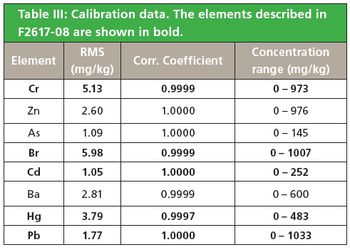
Application Notebook
This application note demonstrates the analysis of lead, cadmium, mercury, chromium, and bromine in polymers, compliant to ASTM F2617-08. The TOXEL and RoHS Calibration Standards were used to set up the calibration on Epsilon 5. The accuracy of the calibration is demonstrated by determination of European Reference Material (ERM) EC681k.
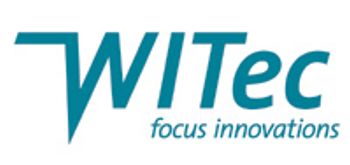
Application Notebook
The development of advanced polymeric materials requires detailed information about the phase separation process on the nanometer scale. Confocal Raman microscopy contributes to the analysis of such materials by visualizing the distribution of individual components based on the unique Raman spectra for different polymeric materials. Using a confocal setup, polymer domains can be imaged three-dimensionally with a resolution down to 200 nm. As a Raman image typically consists of tens of thousands of spectra, a powerful data analysis software is essential in order to extract the relevant information. Hidden structures in the images should ideally be visualized automatically, ensuring an objective and consistent interpretation of the imaging data.

Application Notebook
A drug-eluting stent (DES) is an expandable metal alloy framework placed into narrowed coronary arteries that slowly releases a drug coating to treat atherosclerosis. Production of DES is a labor-intensive batch process that requires very tight control. Fourier Transform Near-InfraRed spectroscopy (FT-NIR) is an efficient technique to perform accurate quantification of the different components in DES coating solutions.

Application Notebook
A prerequisite for a successful biotherapeutic formulation is one where the protein is stable and correctly folded. The new technique of dynamic multi-mode spectroscopy (DMS) was used to study the stability of a monoclonal antibody biotherapeutic formulated in acetate and lactate buffers. The samples were measured several times over a period of weeks and it became apparent that the antibody behaved differently as it aged in the two formulations, with the lactate formulation imparting greater robustness than the acetate.

Application Notebook
Spectroscopy is planning to publish the next issue of The Application Notebook in February. As always, the publication will include paid position vendor application notes that describe techniques and applications of all forms of spectroscopy that are of immediate interest to users in industry, academia, and government.

Application Notebook
Spectral measurements to 153 nm can be achieved easily and economically with the high-sensitivity Maya2000 Pro with Extra-Deep-UV Option. Nitrogen purging of the spectrometer helps to mitigate water and oxygen absorption in the vacuum ultraviolet.

Application Notebook
Raman Chemical Imaging technology is able to identify and differentiate multiple components in complex formulated nasal spray suspensions based on chemical makeup. Particle size distribution statistics for the ingredient of interest are produced in a rapid, objective and semi-automated manner. Both solitary and aggregated drug particle sizing information may be obtained.

Application Notebook
The analysis of toy samples for toxic trace elements has been undertaken for many years. However, a number of recent cases of toys contaminated with heavy metals has attracted global media attention. This has resulted in an increase in the number of toy manufacturers performing their own 'in-house' testing. This 'in-house' testing is not only to ensure regulatory compliance; it is also proving significantly more cost effective than outsourcing the analysis.
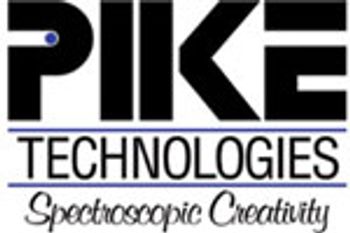
Application Notebook
In ATR/FT-IR, magnified visual monitoring of a sample benefits many applications. For micro-sampling and defect analysis, viewing capabilities decrease overall measurement time by allowing the user to locate the desired sampling area quickly and enhance confidence in the collected data by assuring the sampling point. Visual changes in the sample also may be easily monitored during testing. As an example application, the ease of micro-sampling is shown through fiber analysis and the results are discussed.
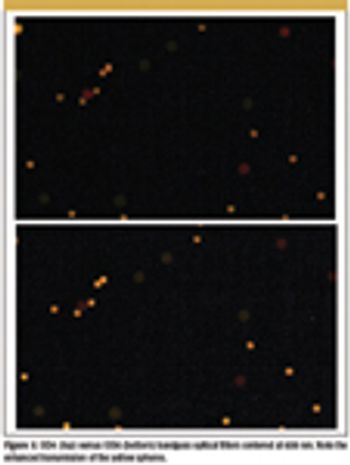
Application Notebook
The use of filters in optical microscopy has become so commonplace that it is hard to find a biological microscope that does not have some type of filter accessory kit. For particular modalities, such as two-photon imaging, the use of optical filters is essential to make the method viable. Filter technology has progressed steadily over the past few decades, moving away from simple colored glass filters to complicated thin-film–based optical components. With optical densities commonly reaching values of 4 or greater, spectrally selective imaging has never been more accurate.

Application Notebook
One of the most powerful aspects of Raman microscopy is the capability to do confocal analysis of features inside of a sample without having to prepare or damage the sample to get the important spectral information.

Application Notebook
A new Raman spectrometer system, innoRamâ„¢, has been developed to provide research-grade performance in either a lab or a mobile environment. The Raman analysis of carbon nanotubes using innoRam in comparison with a Raman spectrometer using a conventional front illuminated CCD demonstrates distinctive improvements for innoRam in both sensitivity and signal-to-noise ratio (SNR).

Application Notebook
Ultraviolet (UV) spectrophotometry has a well-deserved niche. Many UV-Vis instruments claim to work to the deep UV. Few instruments optimize for, or cater to, the 120 to 400 nm region. Development and manufacture of ultraviolet lasers, optics, crystalline materials, and resonance Raman instruments, as well as basic research, require a broadly useful instrument for analysis, characterization, and test. Enter McPherson's Vacuum Ultraviolet Analytical Spectrophotometer (VUVAS.)

Application Notebook
High sensitivity Raman analyzers could provide solutions for continuous and automated measurements of low concentration ions or molecules in aqueous solutions for applications in industries including biomedical, mining, agrichemical, pharmaceutical, cleaning, and environmental. As an example for similar applications, the quantitative analysis of low concentration sulfate ion in aqueous solution down to as low as 2.5 ppm by conventional (Non-SERS) Raman is demonstrated.